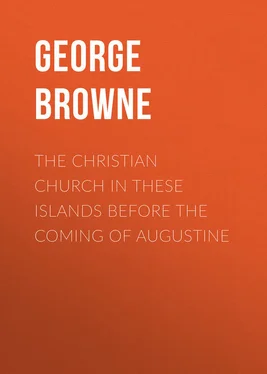But a very curious connection may be made out, between the Britons and the great apostle of the Gentiles.
In speaking of the relations, real or fairly imaginable, between Soissons or Senlis and the English in the parts of the island which lie opposite to that part of Gaul, I asked you to note that this was Belgic Gaul. We have seen that for some time before Julius Caesar’s invasion a change had been going on in the population of those parts of Britain to which I now refer. The Belgae had been crossing the narrow sea and settling here, presumably driving away the inhabitants whom they found. They so specially occupied the parts where now Hampshire is, that the capital city, Went, was named from them by the Latins Venta Belgarum, Belgian Venta; to return in later times to its old name of Caer Went, this is, Went Castle, Winchester. Indeed, the Belgae are credited with the occupation of territory up to the borders of Devon. The British tribe of the Atrebates, again, were the same people as the Gauls in the district of Arras; and they occupied a large tract of country stretching away from the immediate west of London. Caesar remarks on this fact that the immigrant Gauls retained the names of their continental districts and cities. The Parisii on the east coast, north of the Humber, afford another illustration.
Now when Jerome, about the year 367, was at Trèves, the capital of Gaul, situate in Belgic Gaul, he learned the native tongue of the Belgic Gauls; and when later in his life he travelled through Galatia, in Asia Minor, he found the people there speaking practically the same language as the Gauls about Trèves. Thus we are entitled to claim the Galatians as of kin to the Belgic division of the Gauls, and therefore as the same people with those who from before Caesar’s time flowed steadily over from Belgic Gaul to Britain. That the Galatians were Gauls is of course a well-known fact in history; the point I wish to note is that they were Belgic Gauls. We may therefore see in St. Paul’s epistle to the Galatian churches a description of the national character of the Britons of these parts of the island. Fickleness, superstition, and quarrelsomeness, are the characteristics on which he remarks. The very first words of the Epistle, after the preface, strike a clear and forcible note: – “I marvel that ye are so quickly moved to abandon the gospel of him that called you, for another gospel.” Again, “O foolish Galatians, who hath bewitched you!” “Ye were in bondage to them which are by nature no gods;… how turn ye back again to the weak and beggarly rudiments, whereunto ye desire to be in bondage over again!” “If ye bite and devour one another.” Without at all saying that these national characteristics are traceable in any parts of our islands now, it is evident that they are in close accord with what we hear of the early inhabitants. As also is another remark made in early times, “the Gauls begin their fights with more than the strength of men, they finish them with less than the strength of women.”
The line taken by a recent writer, Professor W. M. Ramsay, in his most interesting and able book, “The Church in the Roman Empire,” traverses this argument about the Galatian Epistle. In opposition to the great divine who for eight years spoke from this pulpit, and made this Epistle a special study for a great part of his life, Professor Ramsay maintains, by arguments drawn from geographical and epigraphical facts not known thirty years ago, when Dr. Lightfoot first wrote, that the Epistle was addressed to the people in the southern part of the Roman province called Galatia, who were not Galatians at all; and was not addressed to those in the northern part, who were Galatians proper, and occupied the whole of the country named from them Galatia. But I use the illustration, notwithstanding this. The controversy is not quite ended yet; and I do not feel sure that the difficulties of the Epistle itself, from Professor Ramsay’s point of view, are very much less considerable than those which Dr. Lightfoot’s view undoubtedly has to face. In any case the Galatians proper were of close kin with the more civilised of our British predecessors – ancestors we may perhaps say – and this at least gives us a personal interest in what at first sight would seem to be a very far-off controversy.
Конец ознакомительного фрагмента.
Текст предоставлен ООО «ЛитРес».
Прочитайте эту книгу целиком, купив полную легальную версию на ЛитРес.
Безопасно оплатить книгу можно банковской картой Visa, MasterCard, Maestro, со счета мобильного телефона, с платежного терминала, в салоне МТС или Связной, через PayPal, WebMoney, Яндекс.Деньги, QIWI Кошелек, бонусными картами или другим удобным Вам способом.
Laurentius, Mellitus, and Justus agreed that it was better for them to go back to their own country, and there serve God with minds at rest, than to live fruitlessly among barbarians who had revolted from the faith (Bede, ii. 5). It was in pursuance of this resolution that Mellitus and Justus crossed the Channel, and Laurentius prepared to follow them.
The last decade of the century usually played an important part in the period which our present consideration covers. From 190 to 200, Christianity made such progress in Britain as to justify the remark of Tertullian quoted on page 54. From 290 to 300, Constantius secured his position. From 390 to 400, the last great stand against the barbarian invaders on the north was made by the help of Roman arms. From 490 to 500, the great victory of the Britons under Ambrosius Aurelianus over the Saxons rolled back for many years the English advance. From 590 to 600, the Christianising of the English began to be a fact.
See page 96.
Ecclesiastical History of the Franks, ix. 37.
Page 120.
Daily Chronicle , June 30, 1893.
Standard , May 30, 1893.
Anglo-Saxon Chronicle (late Canterbury copy). Green, Making of England , p. 111.
There is a very interesting discussion in a recent book, The History of St. Martin’s Church, Canterbury , by the Rev. C. F. Routledge, Honorary Canon of Canterbury, on the meaning of this statement (pages 120, &c.). It seems to me clear that Bede believed the church in question to have been dedicated to St. Martin while the Romans were still in the land. As Martin was living up to 397, and the Roman empire in Britain ended in 407, there is not much time for a dedication to this particular Martin. But our ideas of dedications are very different from those which guided the nomenclature of churches in the earliest centuries of Christianity here. If Martin himself ever lived at Canterbury, and had this church, the difficulty would disappear.
The contradictory instructions given by Gregory on the question of using heathen temples for Christian worship are rather puzzling. They are found in a letter to Mellitus, dated June 15, 601, and in a letter to Augustine, dated June 22, 601. The surmise of Messrs. Haddan and Stubbs that the former date is wrong, and that the letter to Mellitus was later than that to Augustine, is reasonable, and solves the puzzle. On this view, Gregory wrote to Augustine, on June 22, 601, to the effect that the idol-temples must be destroyed. This letter, as we know, he gave to Mellitus, who was in Rome, to be brought by him to England. Then, a few days later, perhaps on June 27, he sent a short letter to Mellitus, to say that he had carefully considered the matter, and had decided that if an idol-temple was well built, it should be cleansed, and consecrated to the service of Christ. It is an interesting fact that the earliest historical testimony to the existence and martyrdom of St. George, who was recognised for so many centuries as the Patron of England, is found in an inscription in a church in southern Syria, dating from about the year 346, stating that the church had been a heathen temple, and was dedicated as a church in honour of the “great martyr” St. George.
Читать дальше












